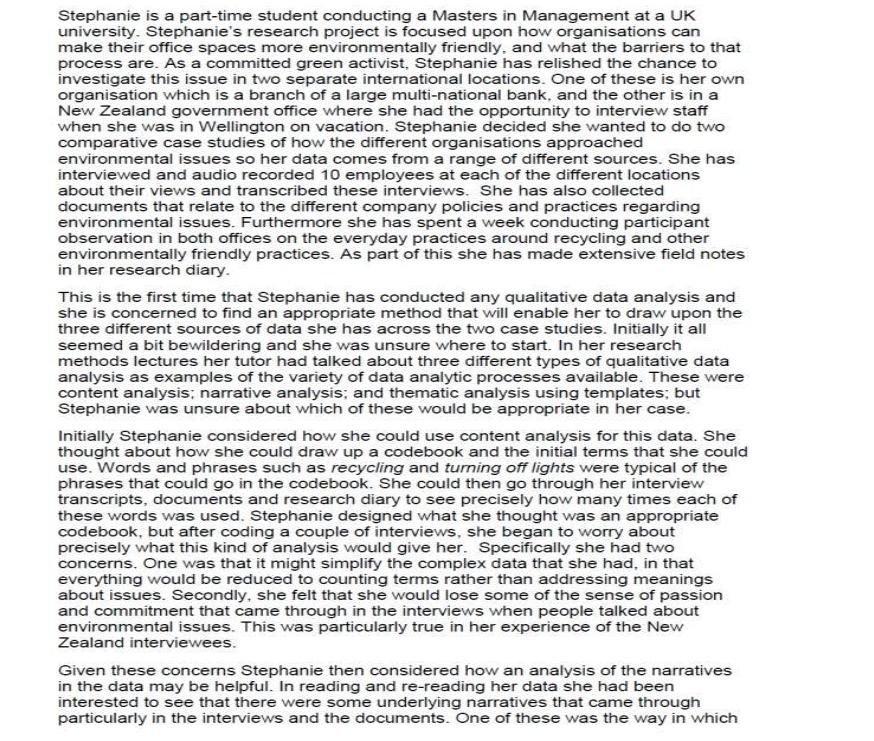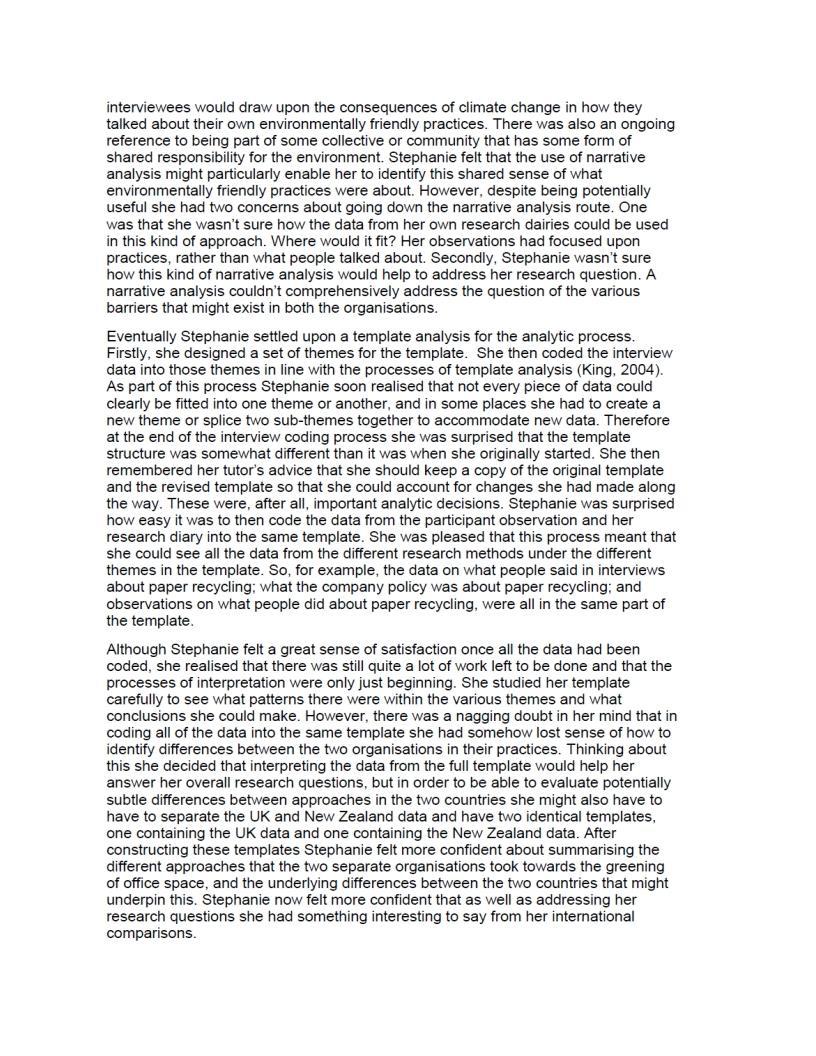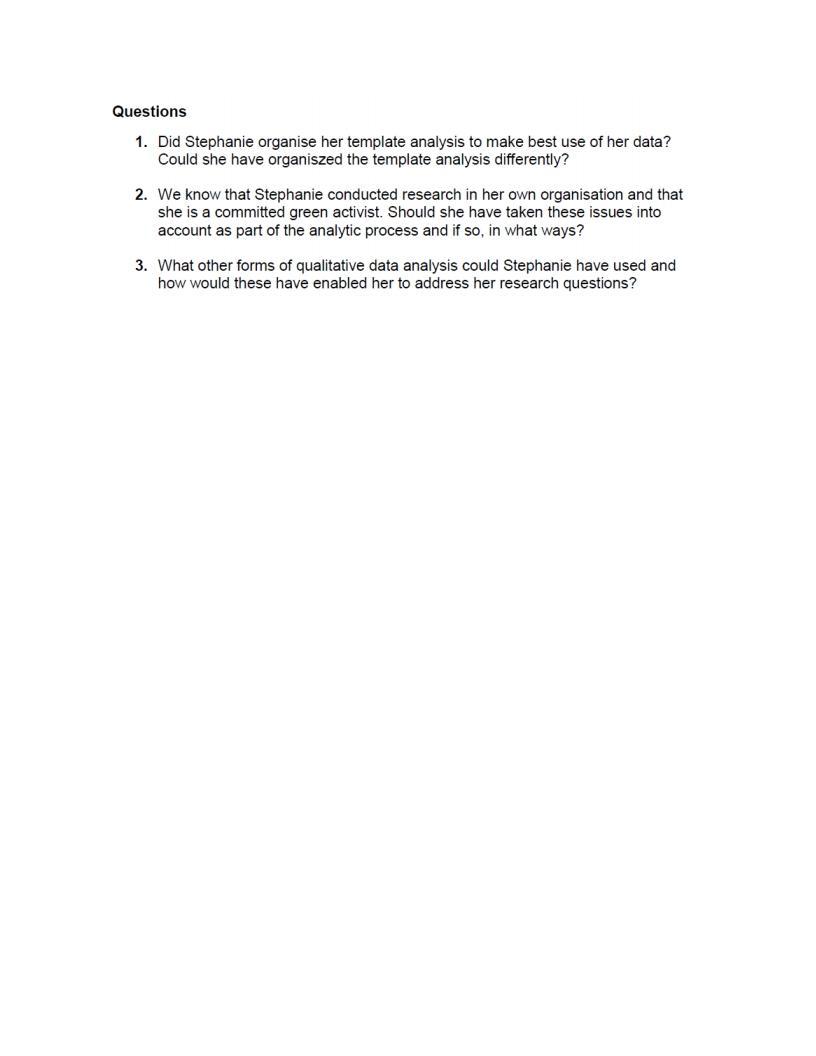Answered step by step
Verified Expert Solution
Question
1 Approved Answer
Stephanie is a part-time student conducting a Masters in Management at a UK university. Stephanie s research project is focused upon how organisations can



Stephanie is a part-time student conducting a Masters in Management at a UK university. Stephanie s research project is focused upon how organisations can make their office spaces more environmentally friendly, and what the barriers to that process are. As a committed green activist, Stephanie has relished the chance to investigate this issue in two separate international locations. One of these is her own organisation which is a branch of a large multi-national bank, and the other is in a New Zealand government office where she had the opportunity to interview staff when she was in Wellington on vacation. Stephanie decided she wanted to do two comparative case studies of how the different organisations approached environmental issues so her data comes from a range of different sources. She has interviewed and audio recorded 10 employees at each of the different locations about their views and transcribed these interviews. She has also collected documents that relate to the different company policies and practices regarding environmental issues. Furthermore she has spent a week conducting participant observation in both offices on the everyday practices around recycling and other environmentally friendly practices. As part of this she has made extensive field notes in her research diary. This is the first time that Stephanie has conducted any qualitative data analysis and she is concerned to find an appropriate method that will enable her to draw upon the three different sources of data she has across the two case studies. Initially it all seemed a bit bewildering and she was unsure where to start. In her research methods lectures her tutor had talked about three different types of qualitative data analysis as examples of the variety of data analytic processes available. These were content analysis; narrative analysis; and thematic analysis using templates; but Stephanie was unsure about which of these would be appropriate in her case. Initially Stephanie considered how she could use content analysis for this data. She thought about how she could draw up a codebook and the initial terms that she could use. Words and phrases such as recycling and turning off lights were typical of the phrases that could go in the codebook. She could then go through her interview transcripts, documents and research diary to see precisely how many times each of these words was used. Stephanie designed what she thought was an appropriate codebook, but after coding a couple of interviews, she began to worry about precisely what this kind of analysis would give her. Specifically she had two concerns. One was that it might simplify the complex data that she had, in that everything would be reduced to counting terms rather than addressing meanings about issues. Secondly, she felt that she would lose some of the sense of passion and commitment that came through in the interviews when people talked about environmental issues. This was particularly true in her experience of the New Zealand interviewees. Given these concerns Stephanie then considered how an analysis of the narratives in the data may be helpful. In reading and re-reading her data she had been interested to see that there were some underlying narratives that came through particularly in the interviews and the documents. One of these was the way in which interviewees would draw upon the consequences of climate change in how they talked about their own environmentally friendly practices. There was also an ongoing reference to being part of some collective or community that has some form of shared responsibility for the environment. Stephanie felt that the use of narrative analysis might particularly enable her to identify this shared sense of what environmentally friendly practices were about. However, despite being potentially useful she had two concerns about going down the narrative analysis route. One was that she wasn t sure how the data from her own research dairies could be used in this kind of approach. Where would it fit? Her observations had focused upon practices, rather than what people talked about. Secondly, Stephanie wasn t sure how this kind of narrative analysis would help to address her research question. A narrative analysis couldn t comprehensively address the question of the various barriers that might exist in both the organisations. Eventually Stephanie settled upon a template analysis for the analytic process. Firstly, she designed a set of themes for the template. She then coded the interview data into those themes in line with the processes of template analysis (King, 2004). As part of this process Stephanie soon realised that not every piece of data could clearly be fitted into one theme or another, and in some places she had to create a new theme or splice two sub-themes together to accommodate new data. Therefore at the end of the interview coding process she was surprised that the template structure was somewhat different than it was when she originally started. She then remembered her tutor s advice that she should keep a copy of the original template and the revised template so that she could account for changes she had made along the way. These were, after all, important analytic decisions. Stephanie was surprised how easy it was to then code the data from the participant observation and her research diary into the same template. She was pleased that this process meant that she could see all the data from the different research methods under the different themes in the template. So, for example, the data on what people said in interviews about paper recycling; what the company policy was about paper recycling; and observations on what people did about paper recycling, were all in the same part of the template. Although Stephanie felt a great sense of satisfaction once all the data had been coded, she realised that there was still quite a lot of work left to be done and that the processes of interpretation were only just beginning. She studied her template carefully to see what patterns there were within the various themes and what conclusions she could make. However, there was a nagging doubt in her mind that in coding all of the data into the same template she had somehow lost sense of how to identify differences between the two organisations in their practices. Thinking about this she decided that interpreting the data from the full template would help her answer her overall research questions, but in order to be able to evaluate potentially subtle differences between approaches in the two countries she might also have to have to separate the UK and New Zealand data and have two identical templates, one containing the UK data and one containing the New Zealand data. After constructing these templates Stephanie felt more confident about summarising the different approaches that the two separate organisations took towards the greening of office space, and the underlying differences between the two countries that might underpin this. Stephanie now felt more confident that as well as addressing her research questions she had something interesting to say from her international comparisons. Questions 1. Did Stephanie organise her template analysis to make best use of her data? Could she have organiszed the template analysis differently? 2. We know that Stephanie conducted research in her own organisation and that she is a committed green activist. Should she have taken these issues into account as part of the analytic process and if so, in what ways? 3. What other forms of qualitative data analysis could Stephanie have used and how would these have enabled her to address her research questions?
Step by Step Solution
★★★★★
3.50 Rating (153 Votes )
There are 3 Steps involved in it
Step: 1
Ans 1 Stephanie has collected the data first and then decided about kind of analysis to be used for interpretation of data thus there may arise chance...
Get Instant Access to Expert-Tailored Solutions
See step-by-step solutions with expert insights and AI powered tools for academic success
Step: 2

Step: 3

Ace Your Homework with AI
Get the answers you need in no time with our AI-driven, step-by-step assistance
Get Started


